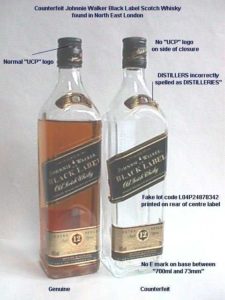By Richard Thomas
As The Whiskey Reviewer examined last week, counterfeit whiskey scams are on the rise around the globe, infesting both the bottom and top shelf ends of the spectrum. Heretofore, the only ways to determine whether a given bottle is a phony is to 1) identify telltale flaws on the bottle; and 2) have the whiskey tasted by a knowledgeable expert to identify the contents. Yet as the case of Hardy Rodenstock’s wine scam demonstrates, neither of these methods is fool-proof, as sophisticated counterfeiters working the high end of the market can and will produce fakes that will pass even the most expert examination.
Now a German research team from Heidelberg University have developed an identification method that may become a valuable tool in exposing fakes. Or maybe not.
Reports indicate that the team has perfected a method whereby the way florescent dyes introduced into a whiskey sample and placed under black lighting will glow differently, creating a fingerprint signature for that particular whiskey. The researchers tested 33 different whiskeys using six dyes and achieved a “99% accuracy rate” in 120 test samples. According to their results published in Chem, this method can be used to make a comparative identification, testing a sample against a known positive, but not to identify samples in and of themselves.
The Scotch Whisky Association, the guardian of the Scotch whisky industry’s interests, relies upon the Scotch Whisky Research Institute to make identifications. They use gas chromatography, high performance liquid chromatography and mass spectrometry.
Because the Heidelberg method involves introducing dyes into samples, it’s best application will probably prove as a cheap method to identify and eliminate the large scale counterfeiting of big brand names appearing in places like India and China. More doubtful is its use to identify expensive, top shelf frauds, since it necessarily destroying samples of both the suspect whiskey and the known, positively identified whiskey that provides the comparison with the introduction of dyes. It’s not likely the owner of a bottle of The Macallan Lalique is going to part with a dram of $40,000 whisky in the name of identifying a forgery.
 The Whiskey Reviewer A World of Whiskey, Poured Every Weekday
The Whiskey Reviewer A World of Whiskey, Poured Every Weekday

